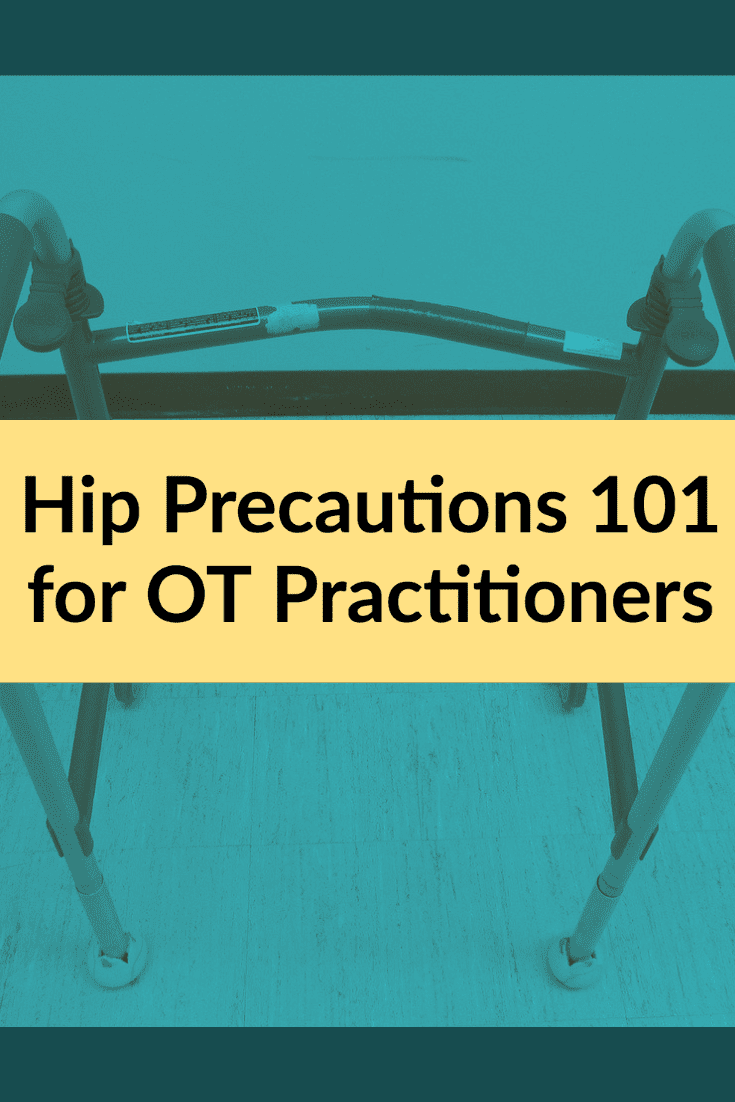As occupational therapists, hip precautions are essential to know, especially with how many patients requiring hip surgery we see. Hip precautions are typically recommended after hip replacement surgery and include movements that the patient should avoid during recovery in order to protect the new hip from dislocation.
It’s important to know the type of surgery, with the most common including:
- anterior hip replacement,
- posterior hip replacement, or
- SuperPATH approach
and the doctor’s specific protocol in order to properly educate your patient after the hip replacement surgery.
If the surgery was completed anterior to the hip, educate the patient on anterior hip precautions. If the surgery was completed posteriorly to the hip, educate the patient on posterior hip precautions. We will work with the patient to education them on hip precautions in a variety of settings including when working in acute care or even in skilled nursing facilities.
So we will be digging into what are the types of precautions for each typical type of surgery and will provide handouts that you can give to your patients on these hip precautions.
[thrive_leads id=’15324′]
Anterior Hip Replacement
During the anterior hip replacement, the incision is made in the front of the patient’s hip. This approach is less invasive as there are less muscles to maneuver through in front of the hip. This also allows the surgeon to easily access the hip without having to cut through major muscles, leading to less pain during recovery.
Recovery time and hospital stay is typically decreased with the anterior approach due to the same reason. Since muscles are not cut with this approach, recovery can take from two to eight weeks.
Anterior Hip Precautions Include:
- No aggressive end range hip extension
- No external rotation (outwards turn of surgical leg)
- No crossing of legs
- No abduction of legs
Posterior Hip Replacement
With posterior hip replacement surgery, the incision is at the back or side of the patient’s hip. Major muscles of the buttocks have to be cut through in order to provide adequate visibility of the hip joint during surgery.
This in turn, can prolong recovery time and potentially the hospital stay. Recovery time can last from two to four months with the posterior approach. This approach although more invasive, remains the approach most used.
Posterior Hip Precautions Include:
- No bending hips past 90 degrees angle
- No internal rotation (keep knees and toes pointing up)
- No crossing of legs
[thrive_leads id=’15324′]
SuperPATH Approach to Hip Replacement
Some surgeons now are even providing an increasingly minimally invasive approach, called the SuperPATH approach (SUPERcapsular Percutaneous Assisted Total Hip), which does not require precautions at all. This allows patients to return to baseline mobility post surgery.
With this approach, the hip is never dislocated, meaning minimal muscle cutting and hip precautions are NOT REQUIRED, but they do typically recommend avoiding extreme positions during transfers and ADL.
Do Patients Even Need Hip Precautions?
Recently there has been a lot of discussion, controversy and research on this topic. The short answer, “no necessarily,” per the research (here is another great article on hip precaution necessity and outcomes), but the real answer is “yes,” because we are to follow the protocol of the surgeon completing the hip replacement surgery and many are still using hip precautions as part of their practice
Patients should be educated on hip precautions prior to (if hospital provides joint education meetings in preparation for surgery) and post surgery upon evaluation prior to mobility. Patients should follow hip precautions at all times until cleared by doctor to return to regular activity.
Reviewing each surgeons hip protocol is essential to best practice and best education for patients.
ADL With Hip Replacement Precautions
Make sure to educate patients on independence with ADL post surgery, as well. Most times this will include education on assistive equipment, adaptive techniques and use of a hip kit.
A hip kit includes:
- a reacher
- long handled sponge
- long handled shoe horn
- sock aid
This equipment allows patients to return to daily activity while still following hip precautions and protecting their surgical hip with activity.
Educate Your Patient on Transfers
Bed Mobility/Transfers
Teach your patients how to roll, get in and out of and reposition in bed while following the recommended hip precautions.
Transfers
Toilet Transfers
Many toilets are too low and would “break” the recommended hip precautions, so recommending a:
- raised toilet seat (I personally like the type that clamps onto the toilet with handles for extra safety) or a
- 3 in 1 commode (the bucket with the hole in the bottom is a splashguard to prevent urine from spraying all over when over a toilet!) to avoid hip flexion past 90 degrees.

 Tub Transfers
Tub Transfers
A tub transfer bench may be necessary to facilitate tub transfers and compliance of precautions with transfer.
It is essential to ask the right questions of home situation and accurately assess patient’s mobility upon evaluation to recommend the appropriate equipment and ensure success at home post discharge.
Once you get a few hip patients under your belt (or hip – get it?) it becomes like riding a bike – instilled in your memory.
Remember, check approach of surgery and surgeon’s protocol, educate patient on recommended precautions (anterior vs posterior), educate on safe ADL activity.
Post by Guiselle Miranda, MOT, OTR, CSRS and Mandy Chamberlain MOTR/L









